DeFi and the Yield Farming Phenomenon
DeFi protocols exploded in all metrics over the last month, passing $3B in Total Value Locked (TVL), triggered by the launch of the Compound governance token ($COMP) and subsequent “yield farming.”
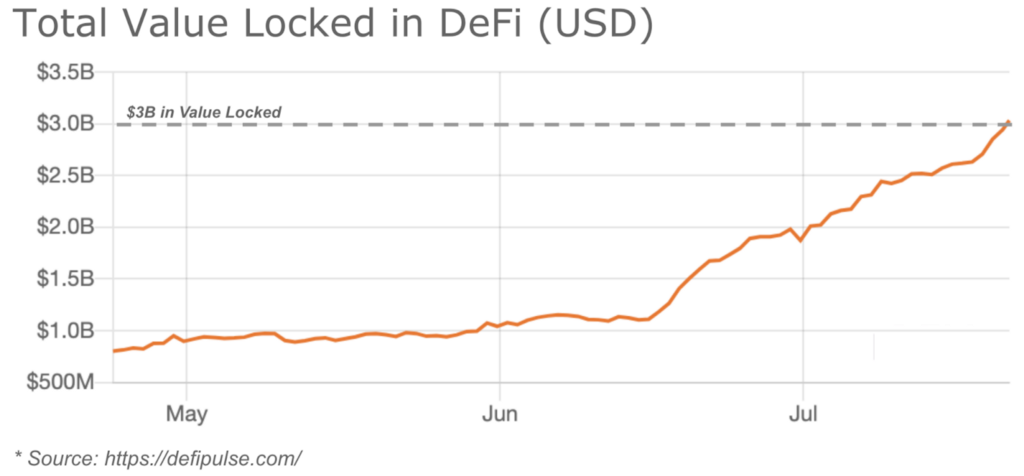
What is Yield Farming?
Most crypto protocols are designed to be decentralized. For base-level networks (like Bitcoin and Ethereum), this is achieved through Proof of Work, where anyone can be a miner and earn some BTC or ETH in exchange for helping secure the network. In so doing, control of the network is more or less democratic (one CPU one vote).
But how do projects built on Ethereum achieve decentralization? One path is to hand over governance in the form of tokens to the users of a protocol, effectively turning users into stakeholders. This is precisely what Compound (an autonomous borrow/lend protocol) pioneered. They are releasing $COMP tokens, which provides governance rights over the Compound protocol, to the users of the network, distributed pro-rata according to how much they use the protocol.
Sounds good, right? Two observations:
$COMP governance tokens holdvalue. Compound is the leading DeFi borrow/lend protocol, and governance rights over this network are powerful.
Distributing $COMP pro-rata to users of the protocol is free yield. It’s an added bonus just for using Compound.
When $COMP was released, the token quickly appreciated in value owing to Compound’s leading position in the DeFi ecosystem. The community quickly realized that adding assets to Compound and/or borrowing against them resulted in significant interest rates due to the additional $COMP being distributed (topping 100% APY at some points).
Ergo, the practice of using a protocol to earn native platform tokens is known as “yield farming.”
What Happened with Compound
Yield farming drove a flood of capital into Compound — in a single week in mid-June nearly half a billion dollars was added to Compound, driving total value locked (TVL) from $100M to over $1.7 B at the peak. $COMP similarly opened trading around $80 and exploded to over $300.
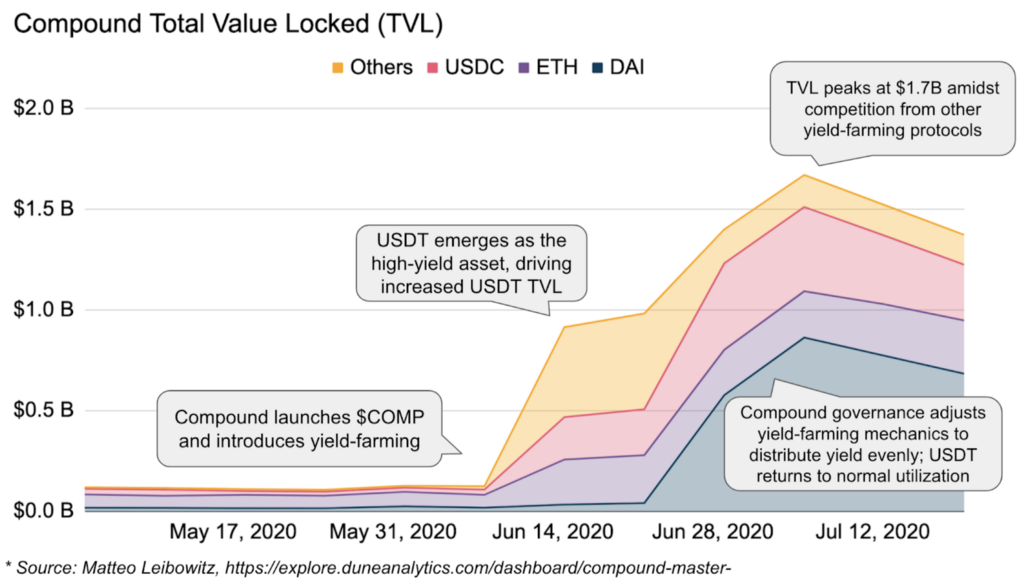
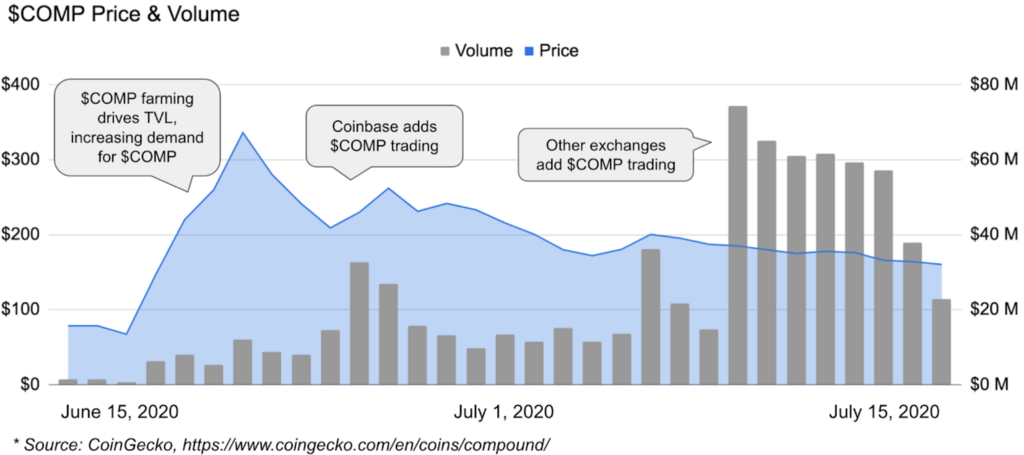
However, not all metrics are as honest as they appear. With Compound, it’s possible to recursively invest your capital, multiplying your yield. It goes like this:
Add 100 USDC as collateral to Compound (earning interest + $COMP)
Borrow 70 DAI against your 100 USDC collateral (paying interest but earning $COMP)
Trade 70 DAI for 70 USDC (bonus: on a DEX)
Repeat Step 1
DeFi composability adds another dimension, where it’s also possible to stack your yield across different protocols. For example, you could lock DAI in Compound, and deposit your compound-DAI tokens into Balancer for additional yield farming.
Popular DeFi tracker defipulse.com does some cleaning on reported TVL to account for these effects. As of July 23, 2020 they report Compound’s TVL at $550M.
Yield Farming is Not Without Risk
In efficient markets, increased yield is reflective of increased risk. While DeFi is a largely inefficient market today, outsized DeFi yields are still indicative of additional risk:
Smart Contract risk: Smart contracts are prone to exploits, with several examples just this year ( bZx, Curve, lendf.me). The surge in DeFi has led to millions in value being slammed into nascent protocols, increasing the incentive for attackers to find exploits.
System design risk: Many protocols are nascent and the incentives can be gamed. (E.g., Balancer, where FTX was able to capture >50% of the yield due to a simple flaw)
Liquidation risk: Collateral is subject to volatility, and debt positions are at risk of becoming undercollateralized in market swings. Liquidation mechanisms may not be efficient, and could be subject to further loss.
Bubble risk: The price dynamics of the underlying network tokens (like $COMP) are reflexive because expected future value follows usage, and usage is incentivized by expected future value.
In general, DeFi protocols with significant capital are honeypots for exploits. In just one week, the Balancer protocol was gamed by an exchange, changed its protocol rules, got hacked, and saw the token price go up 3x! In some ways DeFi is still the wild west — be careful out there.
Downstream effects: A Look at the Broader DeFi Ecosystem
DEX Volume explodes, begins to rival Centralized Exchange volumes
DEX volume rocketed upwards over the last month, and has begun to rival some centralized exchanges.
This is a direct result of yield farming, especially when recursively borrowing and lending requires swapping between two different ERC-20 tokens. Stablecoins have been most preferred (as in the example above), which led to Curve’s rise to dominance (a stablecoin-specific DEX).
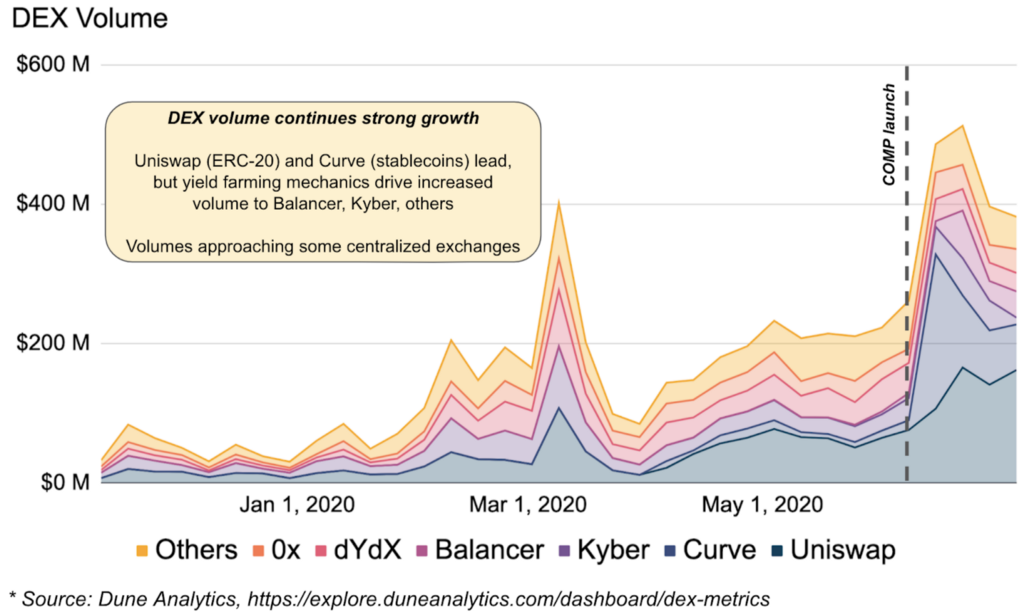
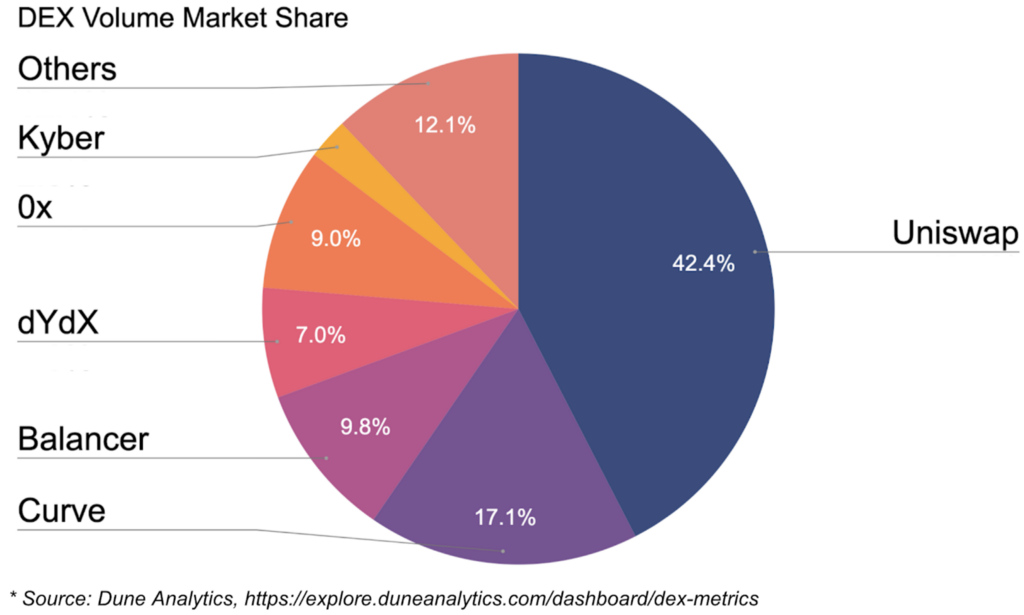
DEXs are also following a similar and proven growth strategy that gave rise to popular exchanges in early 2017: access to the long-tail of tokens / assets not listed on other exchanges. In this case, DEXs provide liquidity for all DeFi tokens and projects. Token creation will likely outpace how quickly centralized exchanges can add them, making DEXs the natural playground for novel new assets and the long-tail of smaller assets.
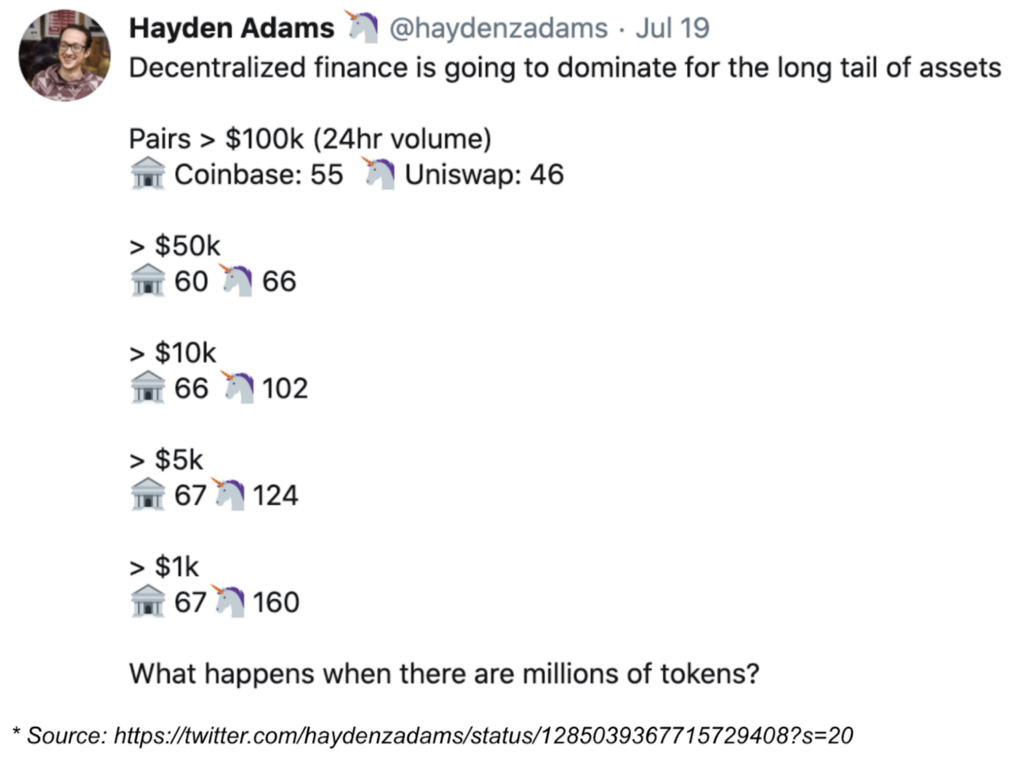
DEXs have done over $1B in total DEX volume over the last 7 days, over 3x of total 2019 DEX volume! More volume than ever is flowing through DEXs. See a prior Around the Block analysis on DEXs and their coming potential for more.
DeFi Stablecoins see strong Q2 growth
Stablecoins used within DeFi (notably Dai and USDC) saw record Q2 growth, as these are preferred yield-farming assets owing to their low volatility which prevents liquidation risk. Both USDC and Dai market caps saw >50% growth, moving from $700M to $1.1B, and $100M to $150M respectively since the launch of $COMP.
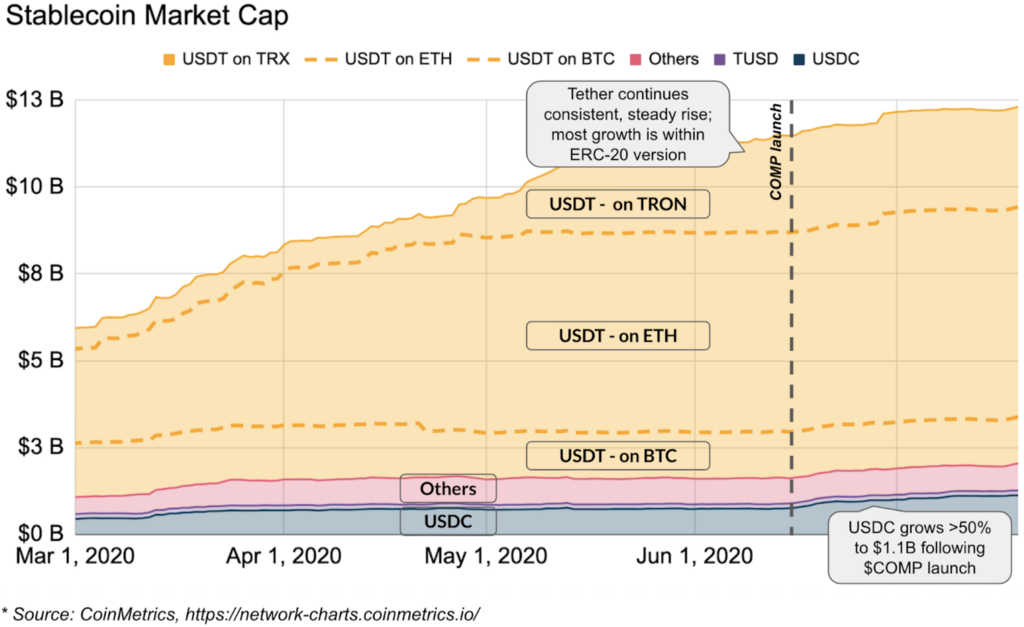
Market Cap of All ETH Tokens Surpasses ETH
The market cap of all ETH tokens recently surpassed the market cap of ETH itself. While driven mostly by a few assets (LINK and CRO), this is still an intriguing flip showing how the ETH ecosystem is expanding in value faster than the base native asset.
If you believe in the fat protocol thesis, then it may indicate ETH is undervalued, as growth in the utility layer would eventually accrue to the base layer. But if you don’t, it could raise questions around Ethereum’s long-term security model, where it might be economically rational to attack Ethereum in order to extract value from assets sitting on top.
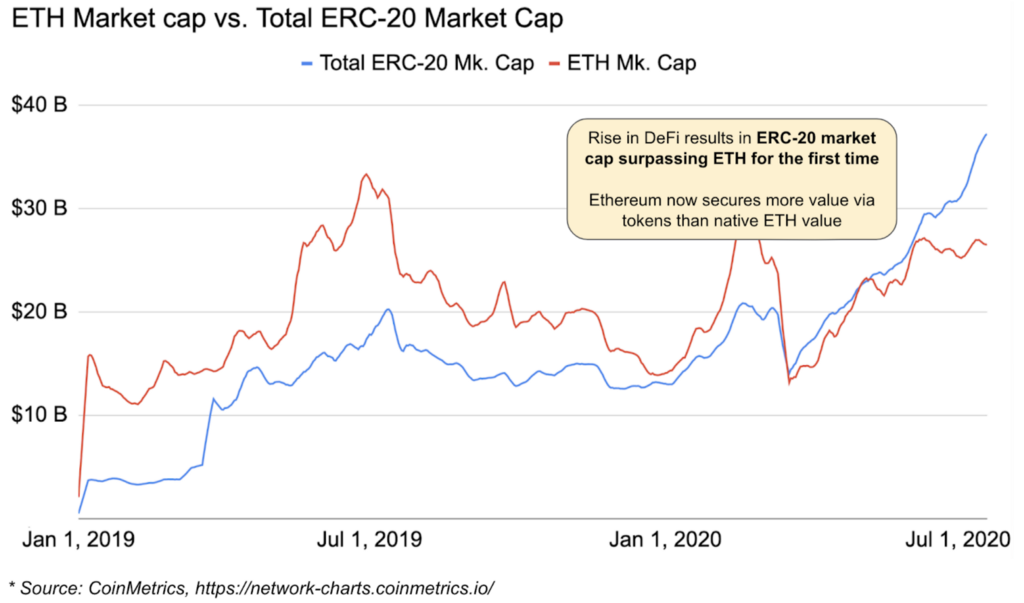
Ethereum Suffers Periods of Congestion; Highlighting Scaling Challenges
Predictably, DeFi activity produced a rise in median gas prices, ranging between 40 and 70 Gwei today. A single ETH transfer costs ~$0.35, but more complex operations like swapping assets on a DEX or entering and exiting multiple yield-farming positions can be substantially more expensive (at times >$10 per transaction).
High gas fees are sneakily insidious because they restrict access to DeFi to only those with sufficient capital. When it costs $10 to enter and exit yield farming positions, the subset of users with limited balances are cut off.
High gas fees are a direct consequence of scaling challenges. While still a drag today, efforts around ETH 2.0 and Layer-2 solutions show meaningful progress, but we’ll have to wait and see how those efforts play out.
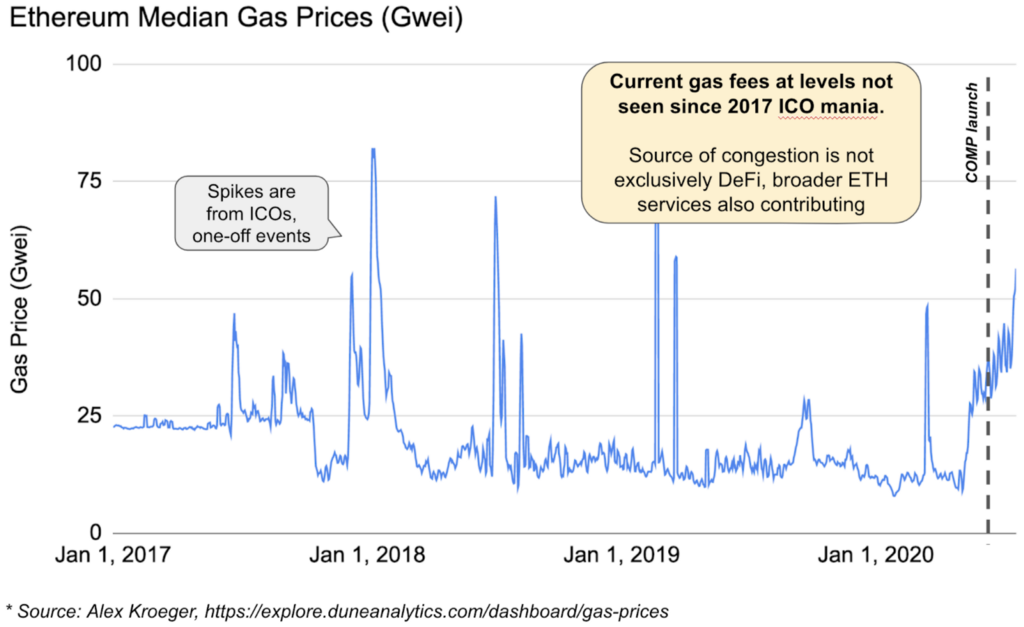
Other DeFi projects surge
Wrapped BTC Projects: Wrapped BTC projects create an Ethereum ERC-20 token that is redeemable 1:1 for BTC on the Bitcoin blockchain, thus marrying the BTC and ETH chains and bringing BTC’s balance sheet into DeFi. These projects rose substantially as users sought out more capital for yield farming. BitGo’s wBTC and Ren’s rBTC are notable standouts, with ~$140M BTC locked between them (and wBTC the clear leader with $130M).
Balancer: A liquidity provider and DEX similar to Uniswap launches with a yield farming governance token, and quickly grows to over $200M TVL.
Aave: A borrow / lend protocol similar to Compound, but with added flash-loan capabilities, a native $LEND governance token, and differentiating loan products. $LEND value has increased significantly following $COMP’s rapid rise, and Aave’s TVL has similarly exploded to over $450M.
Synthetix: A synthetic-asset protocol on Ethereum with similar yield-farming mechanics, Synthetix has also seen incredible growth. Their synthetic dollar sUSD has captured volume amidst the stablecoin explosion.
yEarn Finance: A suite of DeFi products, including a robo advisor that allocates your deposits to the highest-yielding protocols. They released a governance token over the weekend ( $YFI) with unique properties in that it has no previous owners and no outside funding, a fixed supply, and is earned through yield farming. Upon launch, capital rushed toward farming and yields went as high as 1,000% APR.
Infrastructure: Chainlink, aiming to become the oracle bridge powering the suite of crypto and DeFi Dapps, surges to ATH above $8 and cracks top-10 by market cap; InstaDapp surges to nearly $200M in TVL as a simple platform to easily manage yield farming positions.
Others: Ampleforth’s unique “ uncorrelated token” surges; UMA releases a synthetic COMP token (yCOMP) to enable shorts, and a yield-dollar for fixed-interest loans; mStable holds token sale for their stablecoin protocol standard; bZx jumps on with uniswap offering of their governance token.
Implications: Is this activity genuine?
For all the impressive metrics, the rise in asset valuations, and meteoric growth in value locked, is it really genuine activity?
We noted earlier that value locked can be gamed, where assets can be recursively deposited or stacked across other protocols. This has certainly led to some strange results. Consider Compound’s accounting for DAI, where they list more DAI in Compound’s supply than DAI that exists! This can only be possible when the same DAI is supplied, borrowed, and re-supplied in a recursive loop.

So if we can’t take TVL at face value, what can we say about the number of users accessing DeFi?
Numbers are low relative to traction enjoyed by mainstream exchanges (like Coinbase with 35M+ accounts), but the DeFi trend has still driven strong growth, over 100% YTD. Note that there are no “accounts” in DeFi, just unique addresses, so numbers should be taken with a grain of salt.
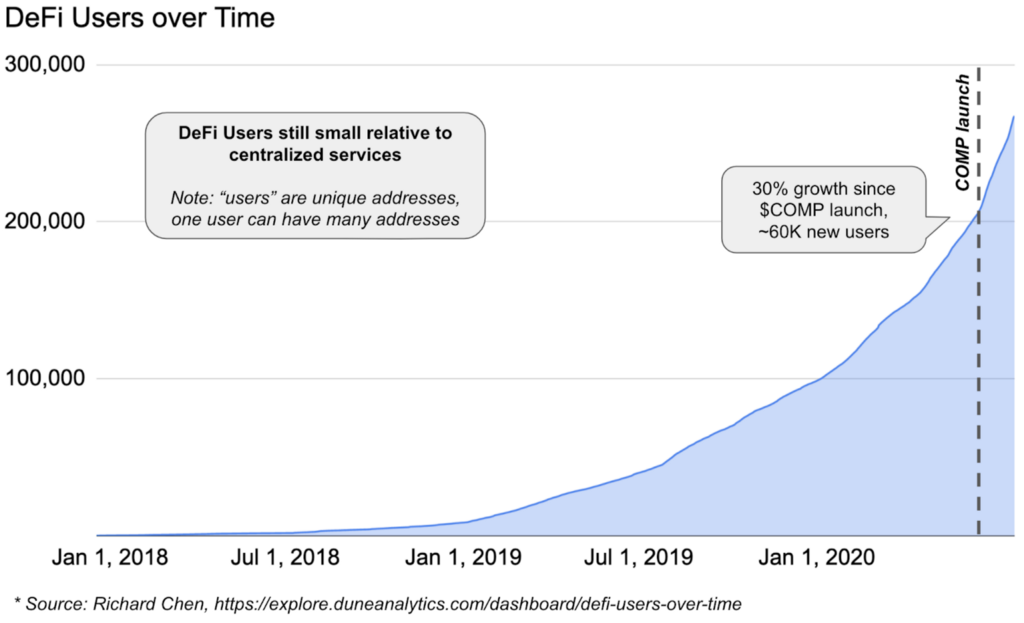
It’s relatively clear that the DeFi phenomenon is still refined to the sophisticated crypto user, able to navigate the world of self-custodial wallets and understand the risks and opportunities that lie within.
And yet, the metrics still cannot be ignored. Even accounting for recursive yield mechanisms, $3B in TVL across all of DeFi is hard to argue against. The traction and usage is on a clear upwards trajectory, and DeFi is the prominent narrative within crypto today.
Are the valuations and returns sustainable?
Taking a step back, we can see a clear cycle:
Protocols add yield-farming governance tokens
Total Value Locked (TVL) increases as users farm governance tokens
Governance token valuations increase on the back of skyrocketing TVL and metrics
Yield farming incentives increase, repeating step 2
Such cycles are usually indicative of valuations divorced from fundamentals.
However, this is how crypto historically bootstraps growth. Outsized financial incentives drive increased user awareness, and people run through brick walls to participate. Over time, the onramps become smoother, the revenue models more refined, and the products get more user-friendly.
So this looks similar to what was happening with Bitcoin in 2013. Only a select few were able to get ahold of Bitcoin back then, but price movements drove awareness and growth. The destinations were a bit sketchy (Mt. Gox), but got much better over time.
Today, DeFi returns are sparking similar levels of awareness, but only the crypto-sophisticated are running through hoops to capitalize. There is some fuzziness in the numbers, but the trend is hard to argue against, and the products and experience will get better over time.
Where the markets and interest rates move from here is speculation, but for more see this insightful Twitter thread.
Links
Coinbase news
Coinbase to acquire leading institutional crypto brokerage, Tagomi
Paul Grewal, former US Magistrate Judge, joins Coinbase as Chief Legal Officer
Coinbase Custody selected by 21Shares for Bitcoin ETP
Compound (COMP) launches on Coinbase Earn and Coinbase Pro
Coinbase open sources software used to integrate new blockchains
Coinbase Custody launches staking for Cosmos
Coinbase prevented Twitter hackers from receiving over $280K in BTC
News from the crypto industry
Twitter accounts of major exchanges, and political figures compromised amidst Twitter hack to perpetuate Bitcoin giveaway scam
Paypal announces plans to add crypto trading services; partners with Paxos
Crypto-card issuer Wirecard implodes, leaving crypto card companies scrambling
Mastercard welcomes Crypto Companies via new card program in partnership with Wirex
Binance to launch crypto payments card in Europe; acquires debit card provider Swipe
Brave partners with Gemini to offer crypto trading in-browser
Institutional crypto news
US Bank regulators approve US Banks to offer crypto custody services
Grayscale reports record $900M inflows in Q2 🔥
BitMEX parent company restructures, potentially exploring products outside crypto
Anchorage announces Anchorage Finance to offer crypto-collateralized cash loans
Galaxy Digital gearing up for Prime Brokerage offering
Huobi to launch options trading
Kraken’s Crypto Facilities wins UK license to offer derivatives trading
News from emerging crypto businesses
Uniswap rivals Gemini’s daily volume amidst DeFi explosion; launches decentralized frontend via IPFS
USDC’s inaugural use for Angel Investment Angel Investment 💪; hits $1B in AUC
FTX adds compound-token markets, enabling exposure to Compound yield farming while trading
Balancer exploited for $500K amidst yield farming phenomenon
UMA launches yCOMP and yield-dollar, enabling shorting on $COMP and fixed-interest loans
Liquid (Bitcoin sidechain) held brief moment where 2 of 3 operators could have stolen all funds
Bitcoin mining hits new All-Time High shortly after halvening
Bitcoin Gold 51% attack attempt foiled by core devs
ETH 2.0 final testnet set to go live; prediction markets show a near 60% chance of going live in 2020
Aave launches service for unsecured P2P loans on ETH
The opinions expressed on this website are those of the authors who may be associated persons of Coinbase and who do not represent the views, opinions and positions of Coinbase. Information is provided for general educational purposes only and is not intended to constitute investment or other advice on financial products. Coinbase makes no representations as to the accuracy, completeness, timeliness, suitability, or validity of any information on this website and will not be liable for any errors, omissions, or delays in this information or any losses, injuries, or damages arising from its display or use. Unless otherwise noted, all images provided herein are the property of Coinbase, and all trademarks are the property of their respective owners.
This website contains links to third-party websites or other content for information purposes only (“Third-Party Sites”). The Third-Party Sites are not under the control of Coinbase, Inc., or its affiliates (“Coinbase”), and Coinbase is not responsible for the content of any Third-Party Site, including without limitation any link contained in a Third-Party Site, or any changes or updates to a Third-Party Site. Coinbase is not responsible for webcasting or any other form of transmission received from any Third-Party Site. Coinbase is providing these links to you only as a convenience, and the inclusion of any link does not imply endorsement, approval or recommendation by Coinbase of the site or any association with its operators.
was originally published in The Coinbase Blog on Medium, where people are continuing the conversation by highlighting and responding to this story.

